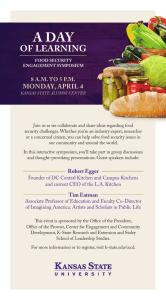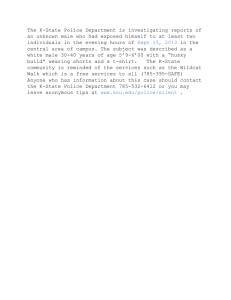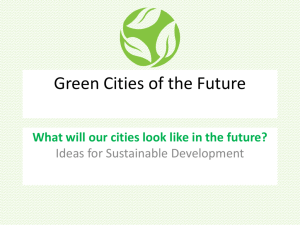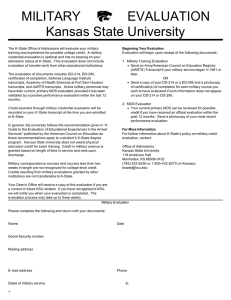May 5, 2008 Dear friends of CECD,
advertisement
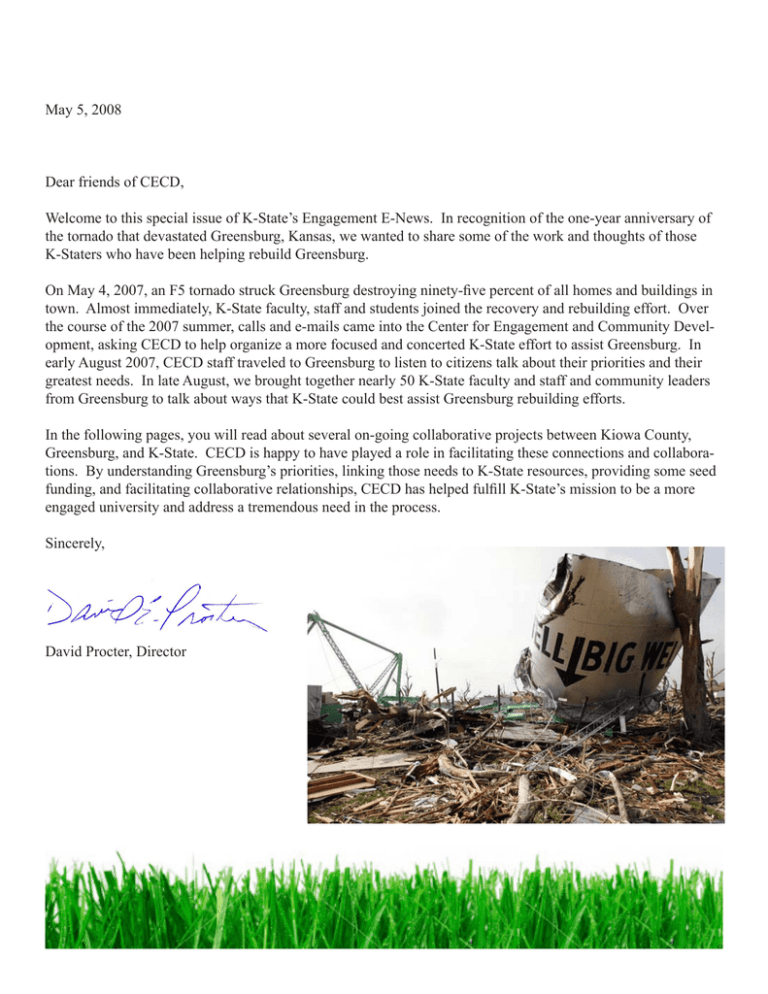
May 5, 2008 Dear friends of CECD, Welcome to this special issue of K-State’s Engagement E-News. In recognition of the one-year anniversary of the tornado that devastated Greensburg, Kansas, we wanted to share some of the work and thoughts of those K-Staters who have been helping rebuild Greensburg. On May 4, 2007, an F5 tornado struck Greensburg destroying ninety-five percent of all homes and buildings in town. Almost immediately, K-State faculty, staff and students joined the recovery and rebuilding effort. Over the course of the 2007 summer, calls and e-mails came into the Center for Engagement and Community Development, asking CECD to help organize a more focused and concerted K-State effort to assist Greensburg. In early August 2007, CECD staff traveled to Greensburg to listen to citizens talk about their priorities and their greatest needs. In late August, we brought together nearly 50 K-State faculty and staff and community leaders from Greensburg to talk about ways that K-State could best assist Greensburg rebuilding efforts. In the following pages, you will read about several on-going collaborative projects between Kiowa County, Greensburg, and K-State. CECD is happy to have played a role in facilitating these connections and collaborations. By understanding Greensburg’s priorities, linking those needs to K-State resources, providing some seed funding, and facilitating collaborative relationships, CECD has helped fulfill K-State’s mission to be a more engaged university and address a tremendous need in the process. Sincerely, David Procter, Director In this issue Interview Interview with with Aaron Bert Biles about Vanderpool the Community Media Center about a K-State architecture project The Center for Engagement and Community Development Interview with Charlie Griffin about emotional support in disasters K-State’s Engagement E-News Special Greensburg Connecting K-State to Kansas and Communities Worldwide Edition how a small Kansas town is committed to green living ating Integr dia e New M and em power citizens n o i t t how Gr a o een munic involve get d in the will imp sburg com rove process The windows were lined with little yellow slips of paper. Little yellow sheets that outlined the happenings for an entire community. Little yellow slips that were THE go-to resource. Let’s hope it didn’t get too humid, or the entire community calendar system would be completely ruined. Bert Biles, the associate director of the National Institute for Land Management and Training, is working to remedy this problem for Greensburg, Kan., residents. “Before the tornado, post-its on the Quick Mart were the only forms of communication, along with a weekly newspaper,” Biles said. “But in order to put information in the paper, you had to plan so far in advance; and that just didn’t work.” Biles explained that active community discussion and deliberation is an essential part of small-town growth. He stressed that citizens need access to news and information — information that is relevant to their specific communities. So Biles and his team are working to create a series of new resources for Greensburg residents. These resources will be available for residents to learn, use and apply to their daily lives. The Community Media Project hopes to empower residents to create their own media, create their own news, become part of the conversation. One component is, as Biles coins it, “the small-town radio station of yesteryear.” The Main Street studio will discuss “Main Street” issues in a talk-radio Special Greensburg edition “ a direct contribution to their community...and learning valuable, job-building media production skills.” The Center for Engagement and Community Development also shares this important goal — to link community members with valuable resources where they can help their communities, and themselves, through a mutually beneficial process. “The combination of these new technologies is “ format. But this golden radio station will have a modern twist — Internet broadcasting. Community members will be equipped with a new Internet radio. The radio will feature a Ethernet cable in the back, but the “old fashioned” design will keep older residents at ease. “We’re trying to capture all the audiences, even ating Integr dia e New M Cont. those that aren’t transformative,” The combination of these technologies is in touch with 21st Biles said. transformative because we can reach areas century technology,” “Now we can that were previously untouched and help said Brandon Utech, reach areas that increase communication using the latest computer systems were previously technology. This will allow local citizens to analyst in the Kuntouched and produce their own information. State College of help communities Engineering. create systems using the latest technology to allow local Other essential components of the Community citizens to produce their own information.” Media Center include video and audio editing software, free Internet hook-ups, and an online Web portal where community members can link information about Components: upcoming events, meetings, and other community • Community Media Center communication. • Free WiMAX-enabled laptops According to the Community Media Center • Video/Audio editing software proposal, these new technologies will not only engage • K-State Research & Extension Office citizens in the local political process, but also allow • Kiowa Co. Public Library • Kiowa Co. Historical Museum/Discovery Center people to “directly participate in designing community journalism, educational programs, and projects, making Technology: How Greensburg is bridging the information apartheid The next generation of wireless technology is here. For users, it functions FACT: WiMAX is the next generation of wireless connectivity. It produces a stronger signal than conventional WiFi. exactly like WiFi — your computer will pick up a signal and connect to the Internet. But for rural Kansas residents, this technology is transformative. In the past, rural residents relied on dial-up or satellite Internet connections. Neither of these is a good option — dial-up is extremely slow, and satellite is expensive. But Greensburg’s new technology will change all that. For a mere $40 a month, residents will have access to unlimited online information from anywhere in Kiowa County. The area will only need three WiMAX transmitters to reach almost the entire county. According to Bert Biles, associate director of the National Institute for Land Management and Training, this technology will cost less than $300,000 for all three towers. Airspan Networks has already offered to pay for one. This technology, combined with the new technologies of the Community Media Center, will help empower residents to create their own media A mere three WiMAX transmitters and become can reach 90 percent of Kiowa more active participants in County’s population. local discussions. FACT: K-State architecture students design green structures for Greensburg residents Last spring, Greensburg, Kan., was devastated by an F-5 tornado. About 90 percent of the town was completely destroyed; and many Greensburg residents were left with no material possessions. Many communities would simply re-build their town in the same manner as before, and as quickly as possible. But Greensburg residents decided it was time for a radical change. The community is choosing to go green. And K-State students are helping with the process. A group of K-State architecture students are taking skills they learned in the classroom and applying them in a real-world context. They are taking their knowledge off paper, and into real life. This process can be difficult at times; but students say it’s also very rewarding. “We wanted to do something that would actually benefit people, real people,” architecture student Aaron Vanderpool said. “Our projects don’t just sit at K-State.” Aaron’s five 5-second ways you can go green 1. Buy compact flourescent light bulbs 2. Unplug electronic items when you leave the house 3. Clean the lint trap on your dryer 4. Put bricks (or other solid items) in your toilet tank 5. Use low-toxin paint the next time you spruce up your house Vanderpool explained that real-world projects allow students to graduate with a deeper sense of how things fit together, and how concepts come to life. These community-oriented projects allow K-State students to show employers that they can not only conceptualize a design, but also that they have the skills to make it work in the real world. This process is not always easy. “Our teacher would often think, they’re so about to fail with this concept,” Vanderpool said. “But For more information: Please visit the Greensburg Cubed video at: http://youtube.com/watch?v=dXYLIvZyFMk then we’d figure it out on our own, and that was so much better.” The series of projects, known as Greensburg Cubed, will bring several 1,000 ft cubed pavilions to Greensburg residents. Different cubes serve different purposes for the community, but each cube is full of “green” technologies. For example, the Ice Cube will work for water filtration and supply. This project is funded by a CECD partner, WaterLINK. Architects working on this project hope the cube will teach Greensburg residents how to conserve water in a variety of ways. Another cube, Green Haus, will teach residents how to add easy green elements to their homes. This learning pavilion will teach both K-State students in the design process and Greensburg residents once the project is completed. Such relationships are often mutually beneficial for the students and the communities they serve — both parties gain valuable skills or services in the process. “Students have a real passion for helping people,” Vanderpool said. “We’re young, we have energy, and when we get pent up in the classroom, we can actually go out and do something.” Griffin coordinates behavioral health program to help Kansas communities in disasters “ community needs in a mutually beneficial way. “CECD works to help communities meet their needs, and sometimes those needs are remarkably devastating,” Griffin said. “We work to be a caring, supporting presence in communities just like so much of CECD’s work is.” Griffin’s team uses the psychological first aid model in their interaction with community residents after a disaster. This model asks, “What can we do to reach out to those around us in a time of need?” Working hand in hand with local agencies, Griffin’s team provides community members with the emotional support they Quote of the Month “ When disaster strikes, a community is not only physically altered, but also mentally. Citizens may have a difficult time analyzing the shocking and instantaneous changes their communities face. But Charlie Griffin and a team of state-wide volunteers are working to counter these problems with positive change. “We provide behavioral health support after a disaster,” said Charlie Griffin, coordinator for the AllHazards Behavioral Health Program. “We were on the ground May 6, 2007, two days after the disaster, and we’ve been there ever since.” Immediately after the tornado, Griffin helped We have a heavy responsibility to take our resources out in the state in an applied way. -- Charlie Griffin, coordinator for the Kansas All-Hazards Behavioral Health Program coordinate a team of volunteers who entered the community to help. Between May 7, 2006, and midJuly, more than 490 volunteers gave their time to help Greensburg residents heal. At times, this process can be difficult. “We step in to help communities when they don’t have the resources to do so themselves,” Griffin said. “We have a heavy responsibility to take our resources out in the state in an applied way.” This dedication to make the state a better place aligns well with the CECD mission. Both organizations work to combine the resources of K-State with need. The All-Hazards Behavioral Health Program works to help communities with presidentially declared disasters. Teams of full-time employees will stay in the communities to help for one year after the disaster strikes. Currently, the program is also stationed in the nine counties of South East Kansas that were devastated by floods last July. This service provides an integral function for Kansas communities — listening to residents in a time of need and helping them move forward. 5 ways Griffin’s team helps communities after disasters: 1. We work to be a caring, supportive presence. 2. We listen. 3. We encourage residents to talk about what they’re experiencing and share stories. 4. We help people sort out life decisions and set a plan of action. 5. We set people up with the resources they need to make their plans a reality. Special Greensburg edition written and designed by Stephanie Faulk. Faulk works for the Institute for Civic Discourse and Democracy and volunteers for CECD. Contact us at: Center for Engagement and Community Development CECD Mission & Vision Phone: 785.532.6868, Fax: 785.532.6808 E-mail: cecd@k-state.edu Web: www.k-state.edu/cecd Mission To promote engagement across the breadth of Kansas State University - in teaching, research, and outreach - and to connect the vast resources of KSU to the significant issues of public need facing Kansas and communities worldwide. Promoting Civic Engagement Engagement occurs when collaborative partners — both on and off-campus stakeholders — work together to address a public need in a way that is both reciprocal and mutually beneficial. Through engagement, K-State endeavors to fulfill its historic land grant mission. -- David E. Procter, CECD director 202 Ahearn Field House Kansas State University Manhattan, KS 66506-0307 Center for Engagement & Community Development 202 Ahearn Field House Kansas State University Manhattan, KS 66506-0307 3533
